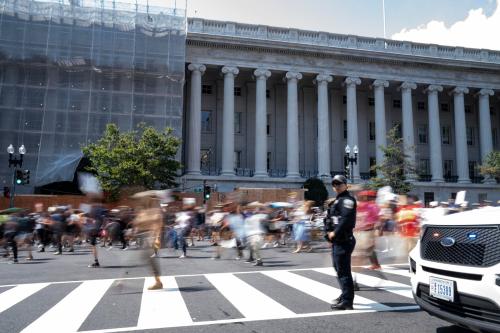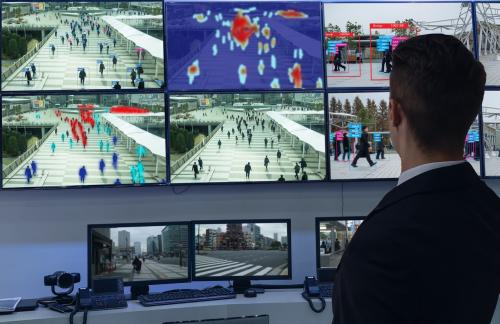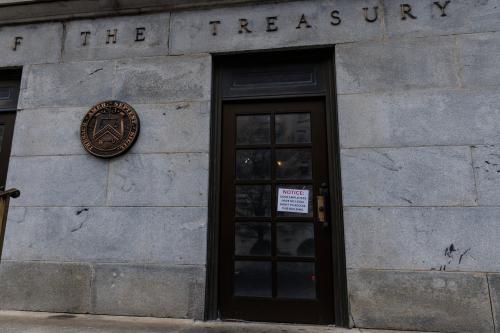Mass deportations were a central promise of Donald Trump’s campaign, with one spokesperson vowing he would “marshal every federal and state power necessary” to achieve such goals. Since taking office, this has included invoking a wartime act and deploying the National Guard to support immigration raids amid protests in Los Angeles.
Behind the scenes, these efforts rely on the use of data analytics and several technologies. From social media surveillance to facial recognition, the administration is employing a variety of legacy technological tools and databases amassed during previous presidencies. But as the administration’s deportation efforts accelerate, it seems these technologies might streamline its goals and also become more powerful with artificial intelligence (AI).
Tech capabilities in immigration enforcement
Both Republican and Democratic administrations have ushered in technologies that can help power immigration enforcement. Nearing the end of Biden’s term, the U.S. Department of Homeland Security (DHS) reported nearly 200 uses of AI across its departments, including approximately 20 active use cases by Immigration and Customs Enforcement (ICE). These range from verifying information or finding potential errors in a data set through machine learning to routine uses of facial recognition technology. For example, ICE’s Alternatives to Detention (ATD) program, which allows people without legal status to live in the U.S. during removal proceedings, rather than be put in a detention facility, requires participants to log their whereabouts through an app called SmartLINK. Usually, this involves people taking a photo of themselves and uploading it to the app, which confirms migrants’ identities through facial recognition and their location at a designated place through GPS coordinates. ICE has also deployed AI for its “Hurricane Scores,” an algorithm designed to assess the likelihood that someone will fail to check in with the agency and to inform officers’ decisions during case reviews.
Other use cases include translation services, facial recognition technologies, and “commercially procured” tools like Babel software, which assists CBP in screening social media accounts to “identify potential threats.”
Technologies have also been deployed at the border itself. Customs and Border Protection (CBP) listed about 60 uses of AI in 2024, including autonomous surveillance towers that can detect and predict migration activity. DHS has also tested robodogs, which would be deployed at the southern border.
The expansion under Trump
These technologies adopted from previous administrations could be repurposed by the Trump administration, including in applications that extend beyond a technology’s original planned use case. Some planned use cases include drug smuggling, human trafficking, and transnational gang activity. The chief operating officer of Geo Group, a private prison firm that sells tracking technology to ICE, confirmed the Trump administration’s intention to monitor millions of individuals in removal proceedings, stating that the company has “assured ICE of our capability to rapidly scale up.”
The administration has already adapted several technology use cases to support its mass deportation efforts, including rebranding the “CBP One” app—which had granted immigration parole to nearly one million people since January 2023. In March, it was relaunched as “CBP Home” to encourage individuals to self-deport.
The administration has also adapted its methods of social media surveillance. Though agencies like the State Department have gathered millions of handles and monitored political discussions online, the Trump administration has been more explicit in who it’s targeting. Secretary of State Marco Rubio announced a new, zero-tolerance “Catch and Revoke” strategy, which uses AI to monitor the public speech of foreign nationals and revoke visas of those who “abuse [the country’s] hospitality.” In a March press conference, Rubio remarked that at least 300 visas, primarily student and visitor visas, had been revoked on the grounds that visitors are engaging in activity contrary to national interest. A State Department cable also announced a new requirement for student visa applicants to set their social media accounts to public—reflecting stricter vetting practices aimed at identifying individuals who “bear hostile attitudes toward our citizens, culture, government, institutions, or founding principles,” among other criteria.
The Brennan Center for Justice reports that these plans could expand existing programs to collect social media handles from an additional 33 million people. The administration has already begun advancing such proposals—for instance, Citizenship and Immigration Services (USCIS) has issued a notice proposing the collection of social media identifiers through immigration forms. The State Department also intends to use these tools not only to identify potential legal violations but to screen for “antisemitic activity” or terrorist sympathies, without clearly defining those terms. This represents just one facet of the data the administration plans to use in its immigration crackdown.
Merging data sets
Although vast amounts of data on both U.S. citizens and noncitizens are already held across federal agencies, the Trump administration’s Department of Government Efficiency (DOGE) has sought to centralize some of this information into a shared repository, following an executive order from Trump calling for the elimination of “information silos.” According to Wired, DOGE intends to integrate data from agencies such as the Social Security Administration (SSA) and the Internal Revenue Service (IRS) into USCIS’s “data lake,” which contains information on immigration cases. Additional reports indicate that DOGE and ICE have also requested access to Medicare data to obtain immigrants’ addresses, despite nonresidents being ineligible for the program.
Successive administrations have worked closely with Palantir, a data analytics and technology firm with federal contracts dating back to 2010, to expand the government’s technological capacity for immigration enforcement. Since Trump took office, Palantir has received more than $113 million in federal funds, including $30 million in May to build “ImmigrationOS,” a database system designed to support “selection and apprehension operations” aligned with enforcement priorities, provide “real-time visibility into instances of self-deportation,” and manage logistics across the immigration process. The system is expected to prioritize violent criminals, gang members, and individuals who have overstayed their visas.
The risk of abuses
Criticism of the technologies used by the government to target immigrants has been well documented for years. A key concern with facial recognition, for example, is that it can exacerbate racial disparities in policing and increase the likelihood of misidentifying people of color, largely due to nonrepresentative training data. Some states, such as Illinois, have protections against the collection or use of biometric information through laws like Illinois’ Biometric Information Privacy Act, but no comparable protections exist at the federal level. The Trump administration also replaced Biden-era guidance on the use of AI in federal agencies with its own framework, largely maintaining continuity while consolidating “rights”- and “safety”-impacting AI into a single “high-impact” category. Civil liberties advocates argue that this designation is too narrow, excluding processes that still require human oversight despite the risks of “automation bias.”
AI can misclassify individuals’ criminal records, score people based on incomplete information, and introduce other forms of bias in law enforcement. Even without AI, the sheer expansion of data collection by DOGE and federal immigration agencies has significant implications. Privacy advocates warn that programs designed to facilitate the deportation of noncitizens may also affect U.S. citizens, since agencies must gather data on everyone to determine legal status. Facial recognition technologies used by federal law enforcement—including ClearView AI systems that collect and sell publicly available images—have already faced legal challenges in the U.S., France, and the Netherlands. Americans have limited privacy protections, as the country lacks comprehensive federal privacy legislation, and protections are weaker for noncitizens.
Furthermore, while everyone in the U.S. is theoretically entitled to First Amendment protections, noncitizen have been targeted in immigration proceedings for their speech and activism. Because AI may struggle to interpret nuance or context, using online speech as a basis for removal proceedings could have chilling effects on free expression and public discourse nationwide. Social media screening criteria can be broadly interpreted, and intensified surveillance raises concerns about restricting free speech while setting an alarming precedent. Individuals may self-censor, fearing repercussions for peaceful forms of government criticism, such as writing op-eds or participating in campus protests. Some universities have even advised international students to be cautious about their digital footprints.
The prior administration worked to establish voluntary guidance and nonbinding guardrails to promote the responsible and ethical design and deployment of these technologies in government. In the absence of stronger regulations and a national data privacy standard, however, the current administration has created a “wild west” regarding the repurposing and procurement of surveillance tools that support its immigration agenda.
Moreover, this extensive surveillance is likely to erode trust in the U.S. government, as immigrants may avoid interacting with federal agencies—even for benefits they are eligible for—out of fear of being targeted. The procurement of these databases and advanced AI tools is particularly concerning in the immigration context, given the nation’s history of using antiterrorism and national security measures to disproportionately surveil and infringe upon the civil liberties of minority groups, including Muslim, Arab, Middle Eastern, and South Asian communities after 9/11. Because data can be collected and stored indefinitely, the expansion of immigration surveillance without robust privacy and free expression protections could have far-reaching effects on all Americans.
The Brookings Institution is committed to quality, independence, and impact.
We are supported by a diverse array of funders. In line with our values and policies, each Brookings publication represents the sole views of its author(s).










Commentary
How tech powers immigration enforcement
October 6, 2025